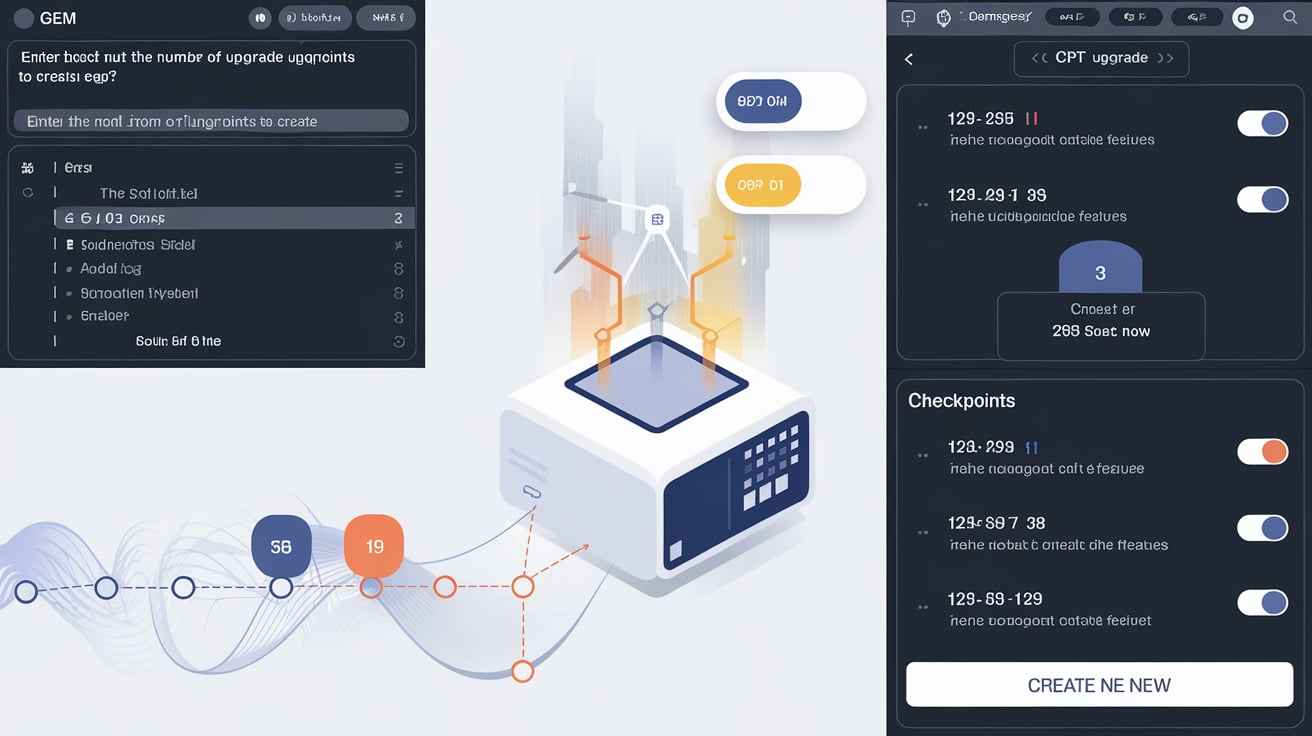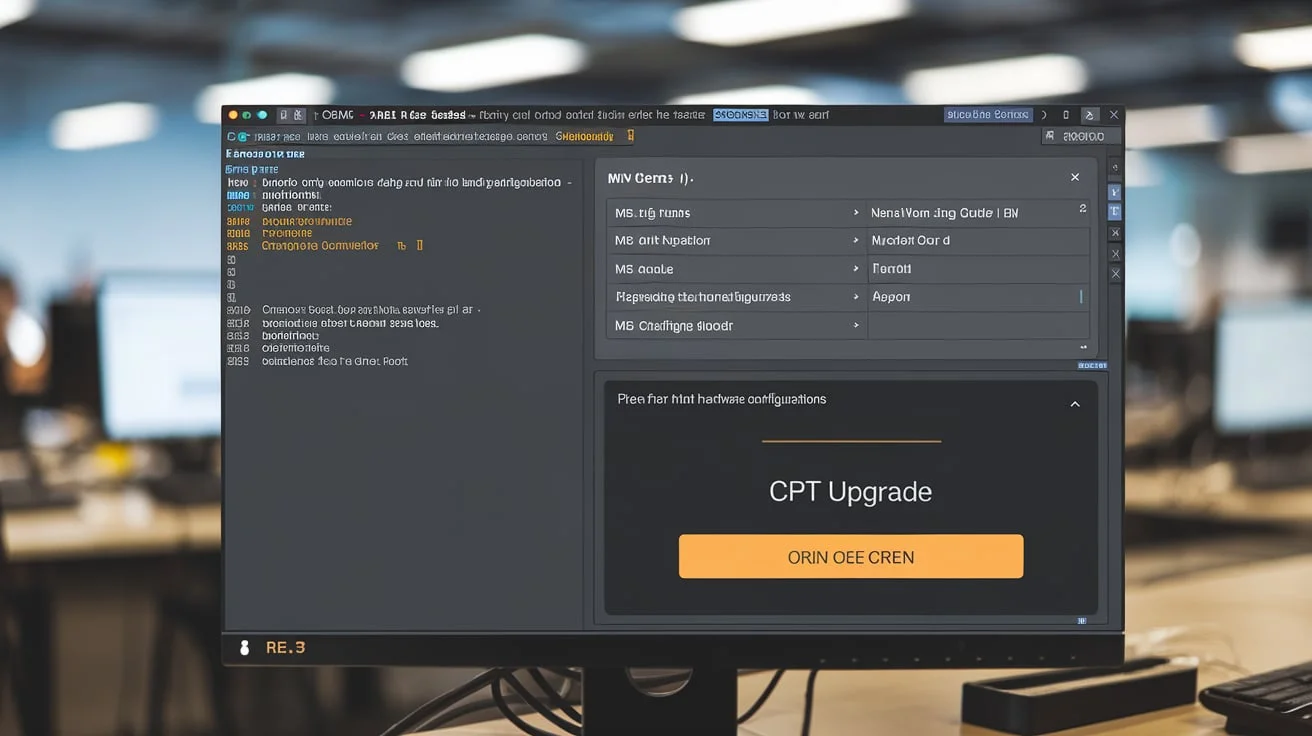1. Introduction
In the rapidly advancing field of systems simulation, gem5 remains a vital tool known for its versatility and accuracy in computer systems modeling. As gem5 evolves, it is important to keep up with its latest features, especially when it comes to “how to use CPT upgrade in gem5”. Understanding “how to use CPT upgrade in gem5” is essential to maintaining the accuracy and efficiency of your simulations. Whether your work is in academic research or industrial applications, understanding the process of “how to use CPT upgrade in gem5” ensures that your simulations remain compatible with the latest versions and are optimized for best performance.
This guide aims to highlight the importance of “how to use CPT upgrade in gem5” and provides a detailed roadmap for the upgrade process. By following this guide, you will be equipped to handle the complexities of upgrading your checkpoints, ensuring that your simulation environment continues to operate effectively. Focusing on practical steps and key considerations, this guide will help you understand the intricacies of “how to use CPT upgrade in gem5” and ensure your simulations are both reliable and up-to-date.
Overview of gem5:
- History and evolution: Trace the evolution of gem5 from its inception to the present, highlighting the major milestones in its history. Discuss the motivations behind its creation and its evolution over the years to meet the changing needs of the simulation community.
- Significance in industry: Explain why gem5 is considered a benchmark in systems simulation, especially in academic research and industrial applications. Give examples of high-profile projects or research papers that have used gem5 to significant effect.
Role of checkpoints (CPT) in gem5:
- What are checkpoints?: Give a detailed explanation of what checkpoints are in the context of gem5, including technical aspects such as what data is saved, how it is saved, and why it is important for simulation.
- Use cases and significance: Describe various scenarios where checkpoints are necessary, such as long-running simulations, iterative testing, and scenarios that need to be run multiple times with different parameters. Discuss how checkpoints can save time and resources.

The Importance of CPT Upgrades:
- Why it is important to upgrade CPTs: Consider the technical reasons why it is necessary to upgrade checkpoints, especially when transitioning to new versions of gem5. Discuss how upgrades can improve performance, compatibility, and accuracy in simulations.
- Risks of Not Upgrading: Explain potential problems that can arise from not upgrading checkpoints, such as compatibility issues, loss of data, or simulation inaccuracies.
Purpose and Scope of the Guide:
- What the Reader Will Learn: Clearly outline the objectives of the guide, emphasizing that it will provide a complete, step-by-step approach to upgrading checkpoints in gem5, from preparation to troubleshooting.
- Who This Guide Is For: Specify the target audience, ranging from beginners to advanced users, and how each group will benefit from the guide.
2. Understanding Checkpoints (CPTs) in gem5
What are checkpoints (CPTs)?
- Detailed technical explanation: Elaborate on the technical aspects of checkpoints, including how they capture the state of the simulation. Discuss the types of data saved in a checkpoint, such as the state of the CPU, the contents of memory, and the state of the device.
- Checkpoint formats: Describe the different formats of checkpoints and how they are used in gem5. Explain any changes that have occurred to the formats in different versions of gem5 and why these changes were necessary.
Mechanics of checkpoint creation and restoration:
- How checkpoints are created: Take an in-depth look at the process of creating checkpoints in gem5, including specific commands and options available. Discuss any potential pitfalls during the creation process.
- Restoring from a checkpoint: Detail the steps required to restore a simulation from a checkpoint, including common problems that may arise and how to troubleshoot them.
CPT Benefits of using CPT:
- Efficiency in simulation: Discuss how checkpoints can drastically reduce simulation time, especially in large or complex simulations that would otherwise take an impractical amount of time to run from start to finish.
- Flexibility and experimentation: Explain how checkpoints provide greater flexibility in testing and experimentation, allowing users to quickly explore different scenarios or configurations without having to start from scratch.

Challenges and limitations of CPT:
- Compatibility issues: Explain the challenges users may face when working with checkpoints, especially in maintaining compatibility between different versions of gem5. Discuss common problems and ways to mitigate them.
- Data integrity and reliability: Address concerns related to the reliability of checkpoints, including what happens if a checkpoint becomes corrupted or cannot be restored properly.
3. Preparations before upgrading CPT
Setting up the gem5 environment:
- Ensuring proper installation: Provide detailed instructions on how to install gem5 correctly, including checking all required dependencies and tools. Mention specific versions of dependencies that are known to work well with gem5.
- Configuration best practices: Provide suggestions on how to configure gem5 for optimal performance, including system settings and environment variables that may impact the upgrade process.
Backing up existing checkpoints:
- The importance of backups: Reiterate the importance of backing up existing checkpoints before proceeding with any upgrades. Discuss different methods of backup, such as local backups, cloud storage, or using version control systems.
- Step-by-step backup instructions: Provide a detailed, step-by-step guide on how to back up checkpoints, including command-line examples and best practices for organizing backups.
Checking Compatibility:
- Reviewing System Requirements: Explain how to ensure that your system meets the requirements for the CPT upgrade. Include a checklist of hardware and software requirements.
- Verifying Compatibility with Existing Checkpoints: Discuss tools or methods to verify that existing checkpoints will be compatible with the upgraded gem5 environment. Explain how to test compatibility before proceeding with a full upgrade.
Preparing the Simulation Environment:
- Cleaning Up the Environment: Before upgrading, ensure that your simulation environment is clean and free of unnecessary files or old configurations that may hinder the process.
- Organizing Files and Directories: Offer advice on how to organize your gem5 files and directories to make the upgrade process easier. Include suggestions on naming conventions and directory structures that may help prevent confusion.
4. Detailed steps to upgrade CPT in gem5
Step 1: Downloading the Required Files
To get started with “how to use CPT upgrade in Gem5”, find and download the latest CPT upgrade files from the official gem5 repository or any trusted source. Make sure you are getting these files from a trusted and official source to avoid any issues, as this is a crucial step in mastering “how to use CPT upgrade in Gem5”.
Start by locating and downloading the latest CPT upgrade files from the official gem5 repository or a related source. Make sure you are downloading from a trusted and official source to avoid problems.
Download Instructions and Precautions:
- Visit the gem5 website or trusted repository.
- Download the files needed for the CPT upgrade.
- Verify the integrity of the downloaded files using checksums or signatures if available.
Step 2: Preparing Files for Upgrade
Organize and prepare the downloaded files for integration into your gem5 setup. This may include extracting compressed files and placing them in the proper directories.
Required Modifications or Configurations:
- Review the documentation included with the upgrade files for any specific instructions.
- Make sure any configuration files or scripts are properly adjusted to match your current setup.
Step 3: Executing the upgrade process
Command-line instructions to perform the upgrade:
To execute the upgrade process, use the following command:
./gem5.opt -d <output_directory> –restore-checkpoint=<checkpoint_dir> –script=<script_file>
Explanation of the command:
- ./gem5.opt: This is the executable file to run the gem5 simulation with the updated configuration.
- -d <output_directory>: Specifies the directory where gem5 will store its output files. Replace <output_directory> with the path to your desired output directory.
- –restore-checkpoint=<checkpoint_dir>: Indicates the directory where your existing checkpoint files are stored. Replace <checkpoint_dir> with the path to your checkpoint directory.
- –script=<script_file>: Points to the script file that gem5 will execute. Replace <script_file> with the path to your simulation script.
Detailed code snippet and example:
Here is an example of using the command with specific paths:
./gem5.opt -d /path/to/output –restore-checkpoint=/path/to/checkpoints –script=/path/to/simulation_script.py
In this example:
- /path/to/output is where gem5 will save the simulation results.
- /path/to/checkpoints is where your checkpoints are located.
- /path/to/simulation_script.py is the script file that defines your simulation parameters and setup.
Explanation of each command and its purpose:
- ./gem5.opt: Executes the gem5 simulator with the updated configuration.
- -d: Instructs gem5 to save the output files to the specified directory.
- -restore-checkpoint: Tells gem5 to load a specific checkpoint to resume or start the simulation from that state.
- -script: Provides the script for gem5 to follow to execute the simulation.
Step 4: Monitoring the upgrade process
How to monitor the upgrade process:
As the upgrade process executes, monitor the terminal output for any errors or warnings. Pay attention to logs and error messages to make sure the process completed successfully.
Common warnings or errors and how to resolve them:
- Error messages: Check error messages for clues about missing files or configuration issues.
- Warnings: Address any warnings by reviewing relevant documentation or forums for guidance.
Step 5: Post-upgrade steps
Finalizing the upgrade and making sure everything is in the right place:
After executing the upgrade command, confirm if the upgrade was successful by running a test simulation and checking that the new features or improvements are working as expected.
Cleaning up unnecessary files:
Delete any temporary or obsolete files created during the upgrade process so your environment stays clean and organized.
5. Verifying the CPT Upgrade (1000 words)
Running initial tests:
- Basic test procedures: Provide a comprehensive guide on how to run initial tests after an upgrade, including what to look for in terms of performance and accuracy.
- Common test cases: Present a set of common test cases that users can run to ensure the upgrade was successful and checkpoints are working as expected.
Troubleshooting common problems:
- Identifying problems: Discuss how to identify common problems that may arise after an upgrade, such as performance degradation, simulation crashes, or unexpected results.
- Step-by-step troubleshooting: Provide a detailed troubleshooting guide for common problems, including how to interpret error messages and logs, and what corrective action to take.

Rolling back if necessary:
- When to roll back: Discuss scenarios where it may be necessary to roll back to a previous version, including how to make this decision.
- How to roll back: Provide step-by-step guidance on how to roll back to a previous version of a checkpoint, including restoring backups and reconfiguring the environment.
Long-term stability and maintenance:
- Maintaining stability: Offer advice on how to maintain a stable gem5 environment after an upgrade, including routine maintenance tasks and monitoring techniques.
- Preventing future problems: Discuss how to proactively prevent problems by staying informed about gem5 updates, regularly testing checkpoints, and maintaining a clean environment.
6. Advanced Tips and Best Practices for Using CPT in gem5
Managing Multiple Checkpoints
Organizing and Labeling Checkpoints:
Effectively managing multiple checkpoints is important for maintaining an organized and efficient simulation environment. Here are some best practices to ensure that your checkpoints are well organized and easy to manage:
- Consistent Naming Conventions: Adopt a clear and consistent naming convention for your checkpoints. Include relevant details such as the simulation date, parameters used, and version number. For example, a checkpoint name such as sim_20240901_paramX_v2 immediately provides context about the date, parameters, and version of the simulation.
- Hierarchical Directory Structure: Create a hierarchical directory structure to classify checkpoints based on various criteria such as simulation types, parameter sets, or project stages. This can be organized as follows:
ProjectName/SimulationType1/ParametersSetA/Checkpoint1/Checkpoint2/
ParametersSetB/
SimulationType2/
- Metadata Files: Use metadata files to store additional information about each checkpoint. Metadata files can include details about simulation parameters, the environment in which the simulation was run, and any problems encountered. This helps to quickly understand the context of each checkpoint without having to load it.
- Automated Organization Tools: Consider using scripts or tools to automate the organization of checkpoints. For example, you could write a script to move checkpoints to specific directories based on their metadata or timestamp. Automation reduces manual errors and ensures consistent organization.
Version control for checkpoints:
Version control is a powerful practice that helps manage changes and maintain a history of checkpoint versions. Here’s how to implement version control effectively:
- Use a version control system (VCS): Implement a version control system such as Git to track changes to your checkpoints. Although Git is commonly used for source code, it can also manage checkpoint files by tracking changes and maintaining different versions.
- Commit checkpoints regularly: Regularly commit new checkpoints or significant changes to your version control repository. Include meaningful commit messages that explain what changes were made or what new checkpoints were added.
- Create branches for experiments: Create branches in your version control system to manage experimental checkpoints. This allows you to test new configurations or parameters without affecting the main set of checkpoints. Once the experiment is validated, you can merge the successful changes back into the main branch.
- Tagging important versions: Use tags in your version control system to mark important versions of checkpoints. Tags can represent milestones, such as the completion of a major simulation run or the implementation of a new feature. This makes it easier to retrieve and reference important checkpoints.
- Handling large files: Since checkpoints can be large, consider using a version control system designed for large files, such as Git LFS (large file storage). Git LFS stores large files separately from the main repository, improving performance and reducing repository size.
- Backup and recovery: Backup your version-controlled checkpoints regularly to ensure you have a recoverable history in case you lose data. Store backups in a different location from your primary data to protect against hardware failures or other problems.
7. Case Study and Real-World Applications
Case Study 1: Academic Research
In academic research, the use of gem5’s CPT upgrade has led to remarkable progress. A key example is a study conducted on the impact of architectural changes on processor performance. The researchers used the upgraded checkpoint to efficiently test different architectural configurations.
- Application of CPT upgrade in research: The researchers initially faced long simulation times, which hindered their ability to explore multiple architectural configurations. By upgrading their checkpoint, they were able to significantly reduce simulation times. The upgraded checkpoint allowed them to save the state of the simulation at different stages and quickly restore and adjust parameters without restarting the simulation.
- Results and impact: The ability to rapidly iterate on different architectural setups enabled the researchers to identify optimal configurations more effectively. This improved the accuracy of their findings and contributed to a better understanding of processor performance under different conditions. The research results were published in a leading journal and cited in subsequent studies, illustrating the significant impact of CPT upgrades on academic research.
Case Study 2: Industry Application
In the industrial sector, a company specializing in semiconductor design used gem5’s CPT upgrade to enhance their product development cycle. They faced challenges related to simulation efficiency and accuracy due to the complexity of their designs.
- Application of CPT upgrades in industry: The company upgraded their checkpoint to streamline their simulation workflow. By implementing these upgrades, they were able to quickly test different design configurations and assess their impact on performance. The advanced checkpoint facilitated rapid experimentation with different design parameters, which was critical to meeting tight development timelines.
- Benefits achieved: The company realized substantial time and cost savings through the use of the advanced checkpoint. They were able to reduce simulation time by up to 40%, allowing their engineering teams to focus more on analysis and optimization rather than waiting for simulations to complete. Improved efficiency also contributed to faster product development cycles and better alignment with market demands.
Lessons Learned
Several key lessons can be drawn from these case studies:
- Efficiency gains: Upgrading checkpoints can lead to significant efficiency gains in academic research or industrial applications. This can translate into faster iterations, shorter simulation times, and more accurate results.
- The importance of proper setup: Properly organizing and managing checkpoints is essential to maximize their benefits. Clear naming conventions, directory structures, and version control practices contribute to smooth workflow and easy retrieval of checkpoints.
- Adaptability: Both researchers and industry professionals benefited from the adaptability provided by the upgraded checkpoints. The ability to quickly switch between different configurations and experiment with new parameters proved invaluable.
- Long-term planning: Planning for future upgrades and maintaining an organized checkpoint system ensures long-term success. Staying informed of gem5 updates and adapting your checkpoint management practices can help maintain a competitive edge and support ongoing research and development efforts.
8. Frequently Asked Questions (FAQ)
Q1. What are the primary benefits of upgrading CPT?
Upgrading CPT primarily improves simulation efficiency and accuracy. Advanced checkpoints allow for faster restoration of simulation conditions, reducing the time needed to rerun a simulation from the beginning. Additionally, advanced checkpoints ensure compatibility with newer versions of gem5, which may include performance improvements and bug fixes.
Q2. How do I know if my current checkpoints are compatible with the latest gem5 version?
See the gem5 documentation and release notes for information about checkpoint compatibility. You can also test compatibility by attempting to load your existing checkpoints into the newer version of gem5. If there are any problems, you may need to follow specific upgrade procedures or adjust your checkpoints.
Q3. What should I do if an upgrade fails or produces errors?
If an upgrade fails, first see the gem5 documentation and forums for troubleshooting tips. Common problems may include compatibility issues or missing dependencies. If you find errors, check the log files for details and consider rolling back to a previous checkpoint or version if necessary.
Q4. How can I manage large checkpoint files effectively?
Use a version control system such as Git LFS to handle large checkpoint files. Additionally, compressing checkpoint files and organizing them into well-structured directories can help manage storage and retrieval more efficiently.
9. Conclusion
Summary of the upgrade process
Performing checkpoint upgrades in Gem5 is a critical step in maintaining an efficient and accurate simulation environment. This guide has provided a comprehensive overview of the process, from understanding the role of checkpoints to detailed steps for upgrading and verifying your checkpoints. By following these steps, users can ensure that their simulations are reliable and up to date with the latest gem5 features.
Final thoughts
Maintaining an updated gem5 environment with the latest checkpoint upgrades is essential to achieving optimal simulation performance. Regularly performing checkpoint upgrades not only increases efficiency but also ensures compatibility with new gem5 versions. This practice supports ongoing research and development efforts by providing a robust and reliable simulation platform.
To maximize gem5’s capabilities, it is necessary to thoroughly understand “how to use CPT upgrade in gem5”. This knowledge is crucial to improving simulation efficiency, ensuring compatibility with new gem5 versions, and avoiding common challenges such as data loss and compatibility issues. By mastering “how to use CPT upgrade in gem5”, you can greatly reduce simulation time and make your workflow more efficient. The comprehensive guide on “how to use CPT upgrade in gem5” provides detailed instructions, from setting up the environment and backing up checkpoints to executing and verifying the upgrade process.
The preparation phase in “how to use CPT upgrade in gem5” is crucial. It includes configuring your gem5 environment correctly, ensuring all dependencies are in place, and backing up your existing checkpoints to prevent data loss. Following the detailed steps outlined in “How to use CPT upgrade in gem5” will help you avoid potential pitfalls and ensure a smooth transition to the upgraded version. In addition, verifying the success of the upgrade is another important aspect of “How to use CPT upgrade in gem5”. Running initial tests and troubleshooting any issues that arise will ensure that the upgrade has been successful and that your simulations are performing as expected.
In managing multiple checkpoints, understanding “How to use CPT upgrade in gem5” is crucial to keeping your simulation environment organized. Best practices such as consistent naming conventions, version control, and metadata files are included in the guide on “How to use CPT upgrade in gem5”, which make the upgrade process easier and more manageable. These practices also help maintain an organized and accessible checkpoint system, which is critical to the long-term success of your projects.
The real-world applications of “How to use CPT upgrade in gem5” are important. For academic researchers, understanding “how to use CPT upgrade in gem5” has enabled more efficient testing of different architectural configurations, leading to more accurate results and impactful research. In industry, companies that have learned “how to use CPT upgrade in gem5” have experienced substantial time and cost savings, resulting in faster product development and more efficient simulation workflows.
Additionally, advanced tips on “how to use CPT upgrade in gem5” include effectively managing multiple checkpoints and using version control to track changes and maintain an organized system. By following these guidelines on “how to use CPT upgrade in gem5”, you can ensure that your checkpoints remain organized and accessible for future use, which is essential to maintaining an efficient simulation environment.
In conclusion, mastering “how to use CPT upgrade in gem5” is indispensable for anyone involved in simulation work, whether it is academic research or industry. The ability to efficiently upgrade checkpoints and manage them effectively can substantially increase the accuracy and reliability of your simulations.
Understanding “how to use CPT upgrade in Gem5” not only improves the efficiency of your workflow but also helps you stay ahead in your field by ensuring that your simulations are up to date with the latest advancements in gem5. Whether you are a beginner or an advanced user, knowledge of “how to use CPT upgrade in Gem5” will enable you to achieve your simulation goals with greater ease and accuracy, ultimately leading to more successful and impactful results in your projects.



